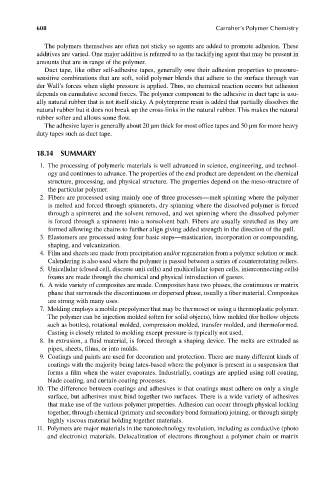Page 645 - Carrahers_Polymer_Chemistry,_Eighth_Edition
P. 645
608 Carraher’s Polymer Chemistry
The polymers themselves are often not sticky so agents are added to promote adhesion. These
additives are varied. One major additive is referred to as the tackifying agent that may be present in
amounts that are in range of the polymer.
Duct tape, like other self-adhesive tapes, generally owe their adhesion properties to pressure-
sensitive combinations that are soft, solid polymer blends that adhere to the surface through van
der Wall’s forces when slight pressure is applied. Thus, no chemical reaction occurs but adhesion
depends on cumulative second forces. The polymer component to the adhesive in duct tape is usu-
ally natural rubber that is not itself sticky. A polyterprene resin is added that partially dissolves the
natural rubber but it does not break up the cross-links in the natural rubber. This makes the natural
rubber softer and allows some fl ow.
The adhesive layer is generally about 20 μm thick for most office tapes and 50 μm for more heavy
duty tapes such as duct tape.
18.14 SUMMARY
1. The processing of polymeric materials is well advanced in science, engineering, and technol-
ogy and continues to advance. The properties of the end product are dependent on the chemical
structure, processing, and physical structure. The properties depend on the meso-structure of
the particular polymer.
2. Fibers are processed using mainly one of three processes—melt spinning where the polymer
is melted and forced through spinnerets, dry spinning where the dissolved polymer is forced
through a spinneret and the solvent removed, and wet spinning where the dissolved polymer
is forced through a spinneret into a nonsolvent bath. Fibers are usually stretched as they are
formed allowing the chains to further align giving added strength in the direction of the pull.
3. Elastomers are processed using four basic steps—mastication, incorporation or compounding,
shaping, and vulcanization.
4. Film and sheets are made from precipitation and/or regeneration from a polymer solution or melt.
Calendering is also used where the polymer is passed between a series of counterrotating rollers.
5. Unicellular (closed cell, discrete unit cells) and multicellular (open cells, interconnecting cells)
foams are made through the chemical and physical introduction of gasses.
6. A wide variety of composites are made. Composites have two phases, the continuous or matrix
phase that surrounds the discontinuous or dispersed phase, usually a fiber material. Composites
are strong with many uses.
7. Molding employs a mobile prepolymer that may be thermoset or using a thermoplastic polymer.
The polymer can be injection molded (often for solid objects), blow molded (for hollow objects
such as bottles), rotational molded, compression molded, transfer molded, and thermoformed.
Casting is closely related to molding except pressure is typically not used.
8. In extrusion, a fluid material, is forced through a shaping device. The melts are extruded as
pipes, sheets, films, or into molds.
9. Coatings and paints are used for decoration and protection. There are many different kinds of
coatings with the majority being latex-based where the polymer is present in a suspension that
forms a film when the water evaporates. Industrially, coatings are applied using roll coating,
blade coating, and curtain coating processes.
10. The difference between coatings and adhesives is that coatings must adhere on only a single
surface, but adhesives must bind together two surfaces. There is a wide variety of adhesives
that make use of the various polymer properties. Adhesion can occur through physical locking
together, through chemical (primary and secondary bond formation) joining, or through simply
highly viscous material holding together materials.
11. Polymers are major materials in the nanotechnology revolution, including as conductive (photo
and electronic) materials. Delocalization of electrons throughout a polymer chain or matrix
9/14/2010 3:43:45 PM
K10478.indb 608
K10478.indb 608 9/14/2010 3:43:45 PM

